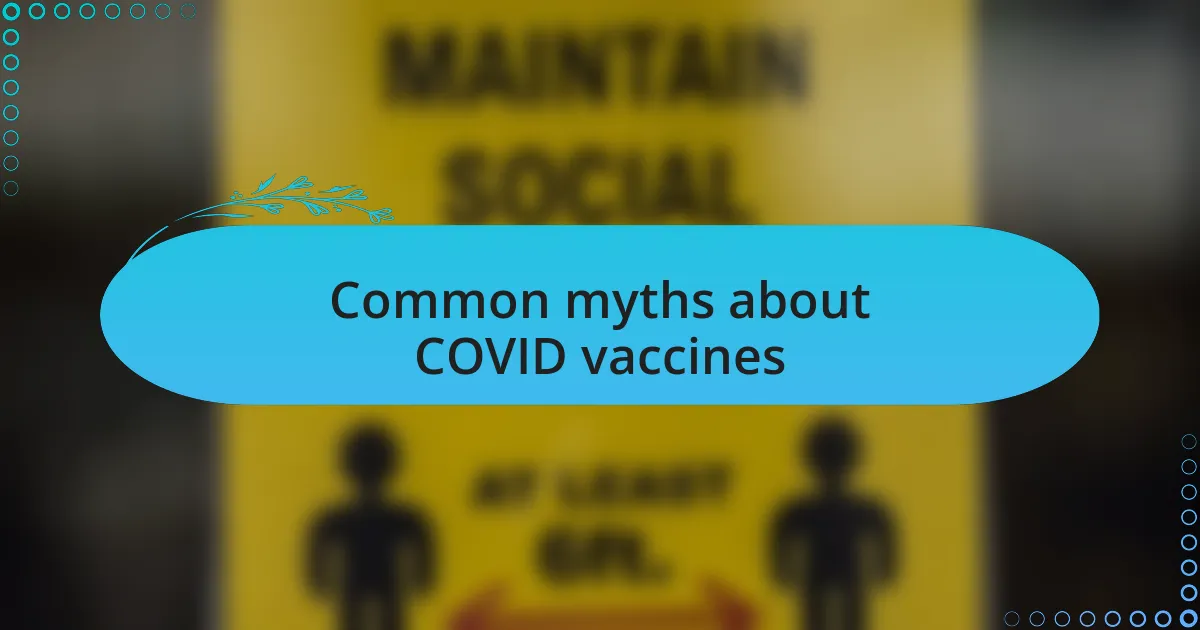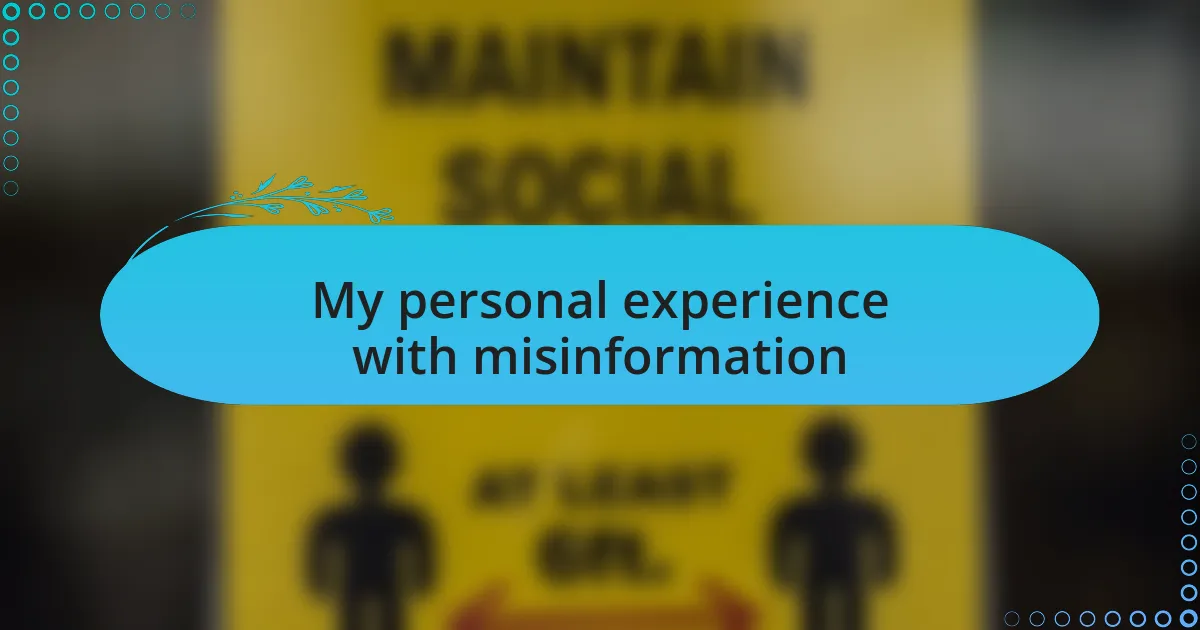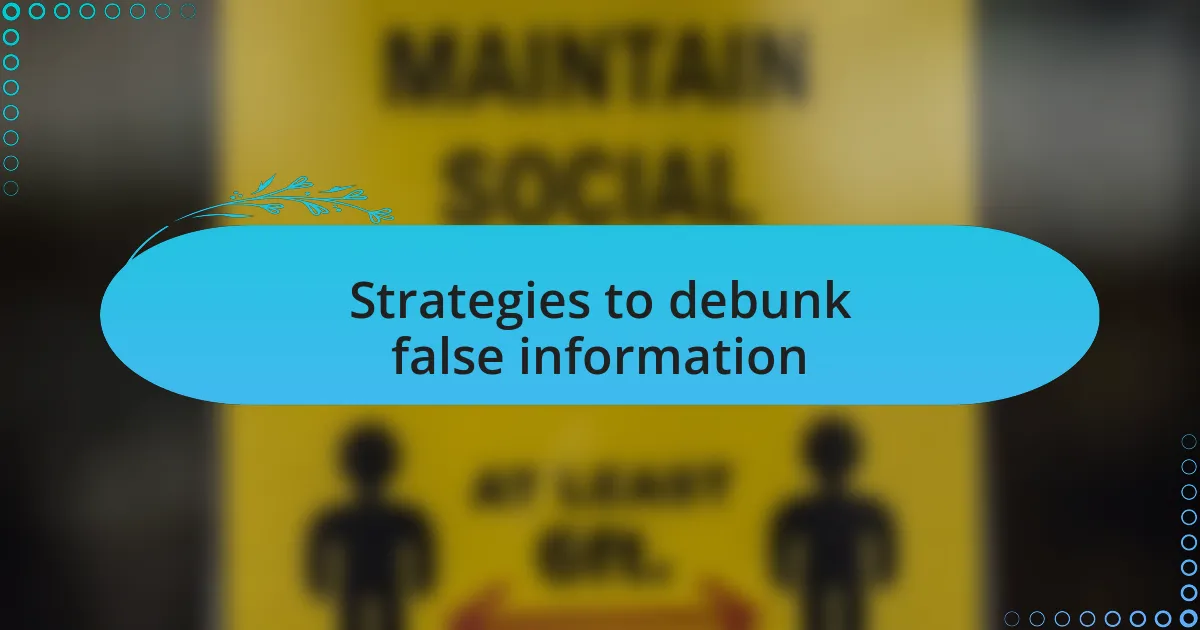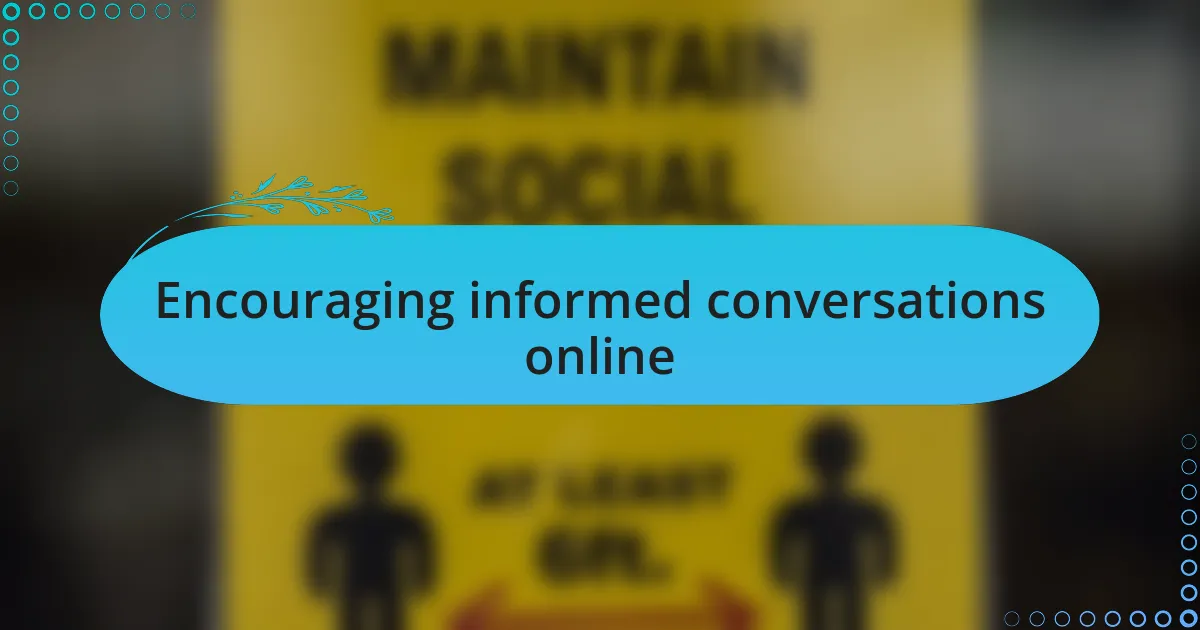Key takeaways:
- Vaccine misinformation often stems from emotional responses and personal anecdotes rather than scientific evidence, highlighting the need for empathy in discussions.
- Common myths include false beliefs that COVID vaccines alter DNA, cause infertility, or guarantee complete immunity from the virus.
- Effective strategies to address misinformation involve meeting people where they are emotionally, utilizing credible sources, and fostering open dialogues instead of confrontational debates.
- Sharing personal experiences can facilitate understanding and encourage more informed discussions within social media environments.

Understanding vaccine misinformation
Vaccine misinformation thrives in the digital landscape of social media, often spreading faster than the truth itself. Reflecting on my own experiences online, I remember scrolling through my feed and encountering posts that claimed dubious vaccine side effects. Each time I saw these alarming statements, I couldn’t help but wonder: why do people choose to share such fearful information instead of seeking out the facts?
In my journey to understand this phenomenon, I found that misinformation often conjures strong emotional responses. For example, during discussions with friends, I noticed that concerns surrounding vaccine safety frequently stemmed from personal anecdotes rather than scientific evidence. It struck me that when fear and doubt take hold, critical thinking can be overshadowed by the gripping narratives that circulate on social platforms.
What I’ve learned is that combating vaccine misinformation requires both empathy and education. When engaging with those who are hesitant or misinformed, I approach the conversation with patience, aiming to understand their perspective. It’s a reminder that underneath every post lies a person grappling with their fears, and addressing those fears can pave the way for informed dialogue.

Common myths about COVID vaccines
One common myth that often circulates is the notion that COVID vaccines can alter your DNA. This misconception is rooted in a misunderstanding of how mRNA vaccines work. I remember discussing this with a colleague who firmly believed that getting vaccinated might change something fundamental about who we are. It took some time, but I explained that mRNA merely instructs our cells on how to protect us from the virus without impact on our genetic material.
Another myth that I frequently encounter is the belief that COVID vaccines lead to infertility. This particular fear has been amplified by misleading claims on social media. I once came across a worried friend who decided against vaccination after seeing a viral post linking the vaccine to fertility issues. I couldn’t help but feel concern for her, knowing that numerous scientific studies have debunked this myth, and I wanted her to have access to accurate information rather than hurtful rumors.
Lastly, some people think that once vaccinated, they are completely immune to the virus. While I understand the desire for a quick return to normal, it’s crucial to stress that no vaccine guarantees absolute protection. I’ve had to remind some of my family and friends that even vaccinated individuals can still contract and spread the virus, and that’s why continuing to follow safety protocols remains essential. Isn’t it interesting how these misconceptions can overshadow the real benefits of vaccination?

Navigating discussions on social media
Navigating discussions on social media can often feel like walking through a minefield. I vividly recall a heated exchange I had on a platform where someone insisted that vaccines were a government plot. I felt a mix of frustration and empathy because I understood that fear often drives such beliefs. Rather than escalating the argument, I chose to share verified resources, hoping to guide the conversation toward facts.
In another instance, I joined a group chat where vaccine skepticism was rampant. Instead of simply dismissing concerns, I decided to listen first. It became clear that many misconceptions stemmed from personal stories rather than scientific evidence. My approach was to share my own vaccine journey, discussing my decision-making process and addressing fears directly—not with a tone of superiority, but with understanding and compassion. Have you ever noticed how honesty can defuse tension?
I also learned the importance of patience during discussions. I remember one night spent debunking myths with a friend who felt overwhelmed by information. We took our time, breaking down claims one by one, which ultimately led to a more productive conversation. This experience taught me that creating a safe space for discussion fosters open-mindedness, enabling better understanding. Isn’t it refreshing when conversations evolve from hostility to mutual respect?

My personal experience with misinformation
My personal experience with misinformation has shown me just how easily fear can cloud judgment. I once encountered a post claiming that vaccines could alter DNA, and it struck a chord with many of my friends. I felt a pang of concern; how could I convey the facts without sounding dismissive? So, I shared a detailed, yet simple, explanation of how vaccines work, which opened the door for a meaningful discussion instead of just arguing.
One afternoon, I received an urgent message from a family member alarmed by a viral video spreading unproven claims about vaccine side effects. As I watched it, I felt a knot form in my stomach. It was personal because I knew my loved one was worried for their own kids. Instead of brushing it off, I sat down with them and processed the information together. We searched for credible sources, easing their worries step by step. Have you ever felt that moment when understanding begins to shine through fear?
Another time, I stumbled upon a thread featuring a conspiracy theory about vaccine ingredients. I couldn’t resist joining in, feeling a mix of indignation and curiosity. I remember typing out my response, acknowledging the emotional weight behind their skepticism and providing facts about vaccine safety. Yet, as I hit send, I paused to reflect: would my voice add constructive dialogue or further entrench opposing views? That moment sparked a realization—the tone of the conversation profoundly affects whether someone will listen or shut down.

Strategies to debunk false information
One effective strategy I’ve found is to meet people where they are emotionally. When addressing someone’s vaccine concerns, I often acknowledge their fears first. For instance, I remember chatting with a coworker who was unsettled about vaccine effects. Instead of diving right into the science, I asked her about her worries, which allowed me to tailor my response and ensure she felt heard.
Another approach is to utilize credible sources as a foundation for your arguments. I once pulled up a report from the CDC while discussing vaccine myths with a friend. Showing him the data side-by-side with his concerns helped bridge the gap between fear and facts. It wasn’t just about sharing information; it was about guiding him toward understanding, which made a noticeable difference in his perspective.
Moreover, engaging in open dialogue rather than confrontational debates can transform the conversation. I once joined a community group discussion online that was rife with misinformation. Instead of attacking the false claims head-on, I reframed the conversation by asking questions that encouraged critical thinking. Questions like, “Have you considered where that information is coming from?” nudged people to reflect on their sources, often leading to more thoughtful discussions and eventual clarity.

Encouraging informed conversations online
When I think about how to encourage informed conversations online, I often reflect on my experiences in various forums. One time, I stumbled upon a heated discussion on social media where misinformation was rampant. Instead of jumping in to correct everyone, I simply asked, “What sources have influenced your views on this topic?” This single question seemed to shift the energy of the conversation. It encouraged participants to think critically about their information sources rather than just responding with emotion.
I’ve also learned the power of sharing personal stories. During an online chat, I opened up about my own vaccination journey—the hesitations I felt, and the relief I found after getting vaccinated. Connecting through personal experiences allowed others to feel more comfortable sharing their feelings, which led to a deeper and more meaningful discussion. It made me realize how relatable narratives can unlock dialogues that are grounded in honesty and understanding.
Finally, I believe that providing a safe space for discussion is vital. In a recent online gathering, I highlighted that it’s okay to be uncertain about vaccines but encouraged everyone to explore their questions collectively. By framing the conversation this way, participants felt empowered to share their doubts and concerns without fear of judgment. Isn’t it amazing how fostering an environment where everyone feels safe to express themselves can lead to richer and more informed discussions?